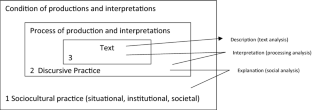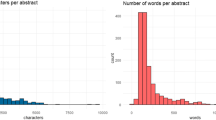Abstract
Using critical discourse analysis, this study examines the representations of gender relations in a popular English textbook series used in primary schools in the Philippines, which is a highly-ranked country in global gender equality indices. It seeks to analyse the persistence of gender inequality in textbooks in a context that is fairly favourable for the promotion of gender equality. The findings indicate that overall gender inequality remains in favour of males. The persistence of male dominance overall despite demonstrable pro-women proclivities of the authors/editors may be a reflection of the enduring gender gap in the country, particularly in economic and political spheres. The implications are rather sobering. If achieving gender equality remains a challenge even among the highly-ranked countries like the Philippines, how much more is the case for over a hundred of lower-ranked countries?

Source: Fairclough (1995, p. 98)
Similar content being viewed by others
Notes
See Gee’s book section entitled, ‘Critical Discourse Analysis’ for a thorough discussion (Gee 2005).
References
Albert, J. R. (2013, March 23). Gender equality in the Philippines: What’s the real score? Retrieved April 3, 2013, from National Statistical Coordinating Board website: http://www.nscb.gov.ph/sexystats/2013/SS20130322_gender.asp.
Ansary, H., & Babaii, E. (2003). Subliminal sexism in current ESL/EFL textbooks. Asian EFL Journal: English Language Teaching and Research Articles, 5(1). Retrieved from http://www.asian-efl-journal.com/march03.sub1.php.
Apple, M. (1986). Teachers and texts: A political economy of class and gender relations in education. New York: Routledge.
Apple, M. (1993). Official knowledge: Democratic education in a conservative age. London: Routledge.
Asadullah, M. N., Islam, K. M. M., & Wahhaj, Z. (2018). Gender bias in Bangladeshi School textbooks: Not just a matter of politics or growing influence of islamists. The Review of Faith & International Affairs,16(2), 84–89. https://doi.org/10.1080/15570274.2018.1469821.
Baldwin, P., & Baldwin, D. (1992). The portrayal of women in classroom textbooks. Canadian Social Studies,26(3), 110–114.
Brugeilles, C., & Cromer, S. (2009). Promoting gender equality through textbooks: A methodological guide. Retrieved April 4, 2013, from http://unesdoc.unesco.org/images/0015/001588/158897e.pdf.
Clark, J. A., & Mahoney, T. (2004). How much of the sky? Women in American high school history textbooks from the 1960s, 1980s and 1990s. Social Education,68, 57–63.
Curaming, R. A. (2017). Hegemonic tool? Nationalism in Philippine history textbooks, 1900–2000. Philippine Studies: Historical and Ethnographic Viewpoints,65(4), 417–450. https://doi.org/10.1353/phs.2017.0031.
Davis, A. P., & McDaniel, T. R. (1999). You’ve come a long way, baby-or have you? Research evaluating gender portrayal in recent Caldecott-winning books. The Reading Teacher,52(5), 532–536.
De Beaugrande, R. (1996). Introduction to text linguistics. London, New York: Longman.
de Beauvoir, S. (1953). The second sex. London: J. Cape.
Fairclough, N. (1989). Language and power. London: Longman.
Fairclough, N. (1992). Discourse and social change. Cambridge: Polity Press.
Fairclough, N. (1995). Critical discourse analysis. London: Longman.
FitzGerald, F. (1979). America revised: History schoolbooks in the twentieth century. Westminster, MD: Random House Inc.
Gavins, J. (2007). Text world theory. Edinburgh: Edinburgh University Press.
Gee, J. P. (2005). An introduction to discourse analysis: Theory and method. Routledge.
Hoey, M. (1983). On the surface of discourse. London: George Allen & Unwin.
Hoey, M. (1991). Another perspective on coherence and cohesive harmony. In E. Ventola (Ed.), Functional and systemic linguistics: Approaches and uses (pp. 385–414). Berlin and New York: Mouton de Gruyter.
Janks, H. (2010). Literacy and power. New York, London: Routledge.
Karasiak, K. (2010). Gender stereotypes in public school textbooks in the Dominican Republic (Master’s thesis). Loyola University, Chicago.
Lazar, M. M. (2005). Feminist critical discourse: Gender, power and ideology in discourse. Palgrave.
Lee, J. F. K. (2019). In the pursuit of a gender-equal society: Do Japanese EFL textbooks play a role? Journal of Gender Studies,28(2), 204–217. https://doi.org/10.1080/09589236.2018.1423956.
McKinsey and Company. (2018). The power of parity: Advancing women’s equality in Asia Pacific|McKinsey. Retrieved January 12, 2019, from McKinsey and Company website: https://www.mckinsey.com/featured-insights/gender-equality/the-power-of-parity-advancing-womens-equality-in-asia-pacific.
Namatende-Sakwa, L. (2018). The construction of gender in Ugandan English textbooks: A focus on gendered discourses. Pedagogy, Culture & Society. https://doi.org/10.1080/14681366.2018.1436583.
Namatende-Sakwa, L. (2019). Networked texts: Discourse, power and gender neutrality in Ugandan Physics textbooks. Gender and Education,31(3), 362–376. https://doi.org/10.1080/09540253.2018.1543858.
Nicholls, J. (2005). The philosophical underpinnings of school textbook research. Paradigm,3(1), 24–35.
Paterno, M. E., & Hermosa, N. (Eds.). (2006a). Our world of reading: Silver secrets. Anvil Publishing, Inc.
Paterno, M. E., & Hermosa, N. (Eds.). (2006b). Our world of reading: Wind by the sea. Anvil Publishing, Inc.
Paterno, M. E., & Hermosa, N. (Eds.). (2006c). Our world of reading: Dream chasers. Anvil Publishing, Inc.
Rodriguez, L. (1990). Patriarchy and women’s subordination in the Philippines. Review of Women’s Studies,1(1), 15–25.
Sadker, D., Sadker, M., & Zittleman, K. (2009). Still failing at fairness: How gender bias cheats girls and boys and what we can do about it. New York: Charles Scribner’s.
Scott, M., & Thompson, G. (Eds.). (2001). Patterns of texts: In honour of Michael Hoey. Amsterdam and Philadelphia: John Benjamins Publishing Company.
Torres, T. (2012, June 24). PH ranks 6th in WB on gender equality. Philippine Star. Retrieved April 3, 2013, from http://www.abs-cbnnews.com/business/06/24/12/ph-ranks-6th-wb-gender-equality.
UNDP. (2000). Millenium development goals. Retrieved April 4, 2013, from http://www.undp.org/content/undp/en/home/mdgoverview.html.
UNESCO. (2003). Education for all: Global monitoring report. UNESCO Institute of Education.
UNESCO. (2007). Promoting gender equality through textbooks: A methodological guide. Paris: UNESCO.
Weinbrenner, P. (1992). Methodologies of textbook analysis used to date. In H. Bourdillon (Ed.), History and social studies—Methodologies of textbook analysis (pp. 85–95). Amsterdam: Swets and Zeitlinger.
Werth, P. (1999). Text worlds: Representing conceptual space in discourse. Harlow, Essex: Longman.
Wharton, S. (2005). Invisible females, incapable males: Gender construction in a children’s reading scheme. Language and Education, 19(3), 238–251.
Wodak, R. (1997). Introduction: Some important issues in the research of gender and discourse. In R. Wodak (Ed.), Gender and discourse (pp. 1–20). London: Sage.
World Economic Forum. (2018). Global Gender Gap Index Report 2018. Retrieved January 12, 2019, from https://www.weforum.org/reports/the-global-gender-gap-report-2018.
Acknowledgements
Eulalia M. Curaming wishes to thank Dr Xiao Lan Curdt-Christiansen for supervising the thesis upon which this paper has been based.
Author information
Authors and Affiliations
Corresponding author
Ethics declarations
Conflict of interest
The authors declare that there is no conflict of interest.
Ethical Approval
Since this study does not involve human subjects, there was no need for an explicit clearance from the Institutional Review Board (IRB) of our universities.
Additional information
Publisher's Note
Springer Nature remains neutral with regard to jurisdictional claims in published maps and institutional affiliations.
Rights and permissions
About this article
Cite this article
Curaming, E.M., Curaming, R.A. Gender (In)equality in English Textbooks in the Philippines: A Critical Discourse Analysis. Sexuality & Culture 24, 1167–1188 (2020). https://doi.org/10.1007/s12119-020-09750-4
Published:
Issue Date:
DOI: https://doi.org/10.1007/s12119-020-09750-4




